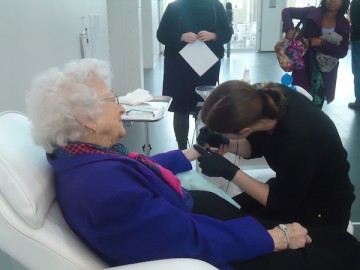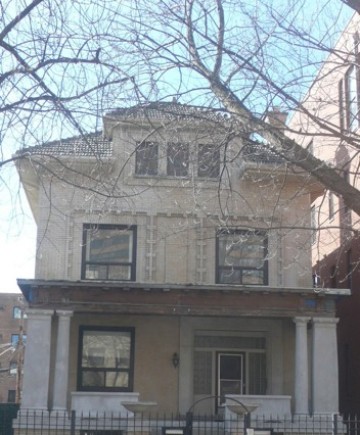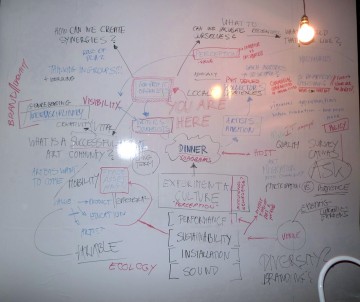The unpredictable and often ephemeral encounters that occur when art, community, audience, and ideas intersect are what excite me most about working with artists. For my last project at the Museum of Contemporary Art, Chicago (MCA)– I left in June 2011 to start 6018NORTH, which I will explain below–we invited artist Mark Bradford to do a community residency. It began immediately at our staff meeting since, instead of me introducing Mark to the staff, he turned it around. He wanted to know what it was the staff did, saying that because they work at the MCA, they each have cultural capital. He then asked, how could they share that capital with others in their field, and in their community? This type of generosity–which Mark brought to the communities in the Lower Ninth Ward in New Orleans, where he sited his ark for Prospect. 1— is important to foster, and it is especially important during a time of economic instability and uncertainty: we need to share our cultural capital.
With Interactions: A Four-Month Companion Series of Artist and Audience Activations, an MCA show which involved 17 artists or artist groups (one each week from Jan – May 2011), I asked how each could encourage audiences to perform, engage, or open up to an artistic experience. The last work, Mnemonic, by artist Katrina Chamberlin, invited the public to receive an actual tattoo of a small black dot. An elderly woman asked for a tattoo. Sitting in the chair, she gathered a crowd because it meant something different for her to get a tattoo as opposed to someone young. During the process, she said to Katrina: “It’s so important that you have done this. You’ve brought so much love and connection to people.” Partnerships and participation are key: people want to be participate in something larger than themselves.

Katrina Chamberlin giving a participant a tattoo as part of her work "Mnemonic," at the MCA Chicago.

A woman displaying the tattoo she received as part of Katrina Chamberlin's "Mnemonic" at the MCA Chicago.
Participation also builds empathy. “Change the environment and you change the people.” I copied this from somewhere, so I can’t take credit for it, but in curating or creating art, architecture, or design, we are changing the environment. We provide the opportunity for people to see the world around them with new eyes. On September 27, 2011 in Chicago at the Jane Addams Hull House Museum’s weekly RE-THINKING SOUP series, farmer/activist John Kinsman from The Family Farm Defenders asked, “How can we change competition into cooperation?”
At 6018NORTH–my new non-profit, green space for performance, sound, and installation art–I am asking how can we open up a communal environment on two platforms: in the home, and in the public sphere. We recently acquired a large (4200 sq. foot) home on the far north side of Chicago built in 1910, hence the inclusion of NORTH. Artists Chelsea Culp and Ben Foch, who run the Chicago gallery New Capital, and I have discussed the power of designing your life to accommodate your artistic/curatorial practice, an integral part of the job of an artist or a curator. I’ve always wanted to run a kind of performance space in my house, which is interesting because as a curator I was usually in the galleries welcoming people as if they were in were my home. Now my home is serving as an experimental model for building a self-sufficient and sustainable community through culture.
The house has suffered extensive flood damage, so for now rather than a presenter, I’m a host for dinners to discuss Chicago art and how to foster the kind of environment I want to be a part of. Throughout history, certain cities became a nexus. Our conversations ask, how can Chicago be that nexus? For the first dinner, we wanted to discuss incubation, since Chicago is known as a city that incubates its artists. Working with artist Adelheid Mers, who diagrammed our conversations, we asked how we could incubate ourselves, what might that look like? In addition, coming from a theatre background, I am obsessed with this question: Why are people able to spend at least $20 for a play that they may not like, and yet for some reason they can’t find the time to walk into a gallery that offers free wine? So in the dinner group that included writers and journalists, we discussed writing’s role within the art community and in building audiences, and the barriers between art and the public.
The second platform of 6018NORTH is the more public platform, which occurs in public spaces in order to ask how art and culture can be integrated into neighborhoods and communities, so that the public doesn’t feel art is somewhere out there and far away. In my next few posts, I’ll talk more about these ideas along with the following projects – my storefront, Art Platform LA, Pacific Standard Time, The Happiness Project, and Occupy Wall Street. After that, I will discuss political conversations in art including P.S.1’s 9/11 show and the Istanbul Biennale, as well as new economic models and sustainable options for art. Finally, I’ll discuss how a new study on the Mona Lisa illustrates what I look for in art.





